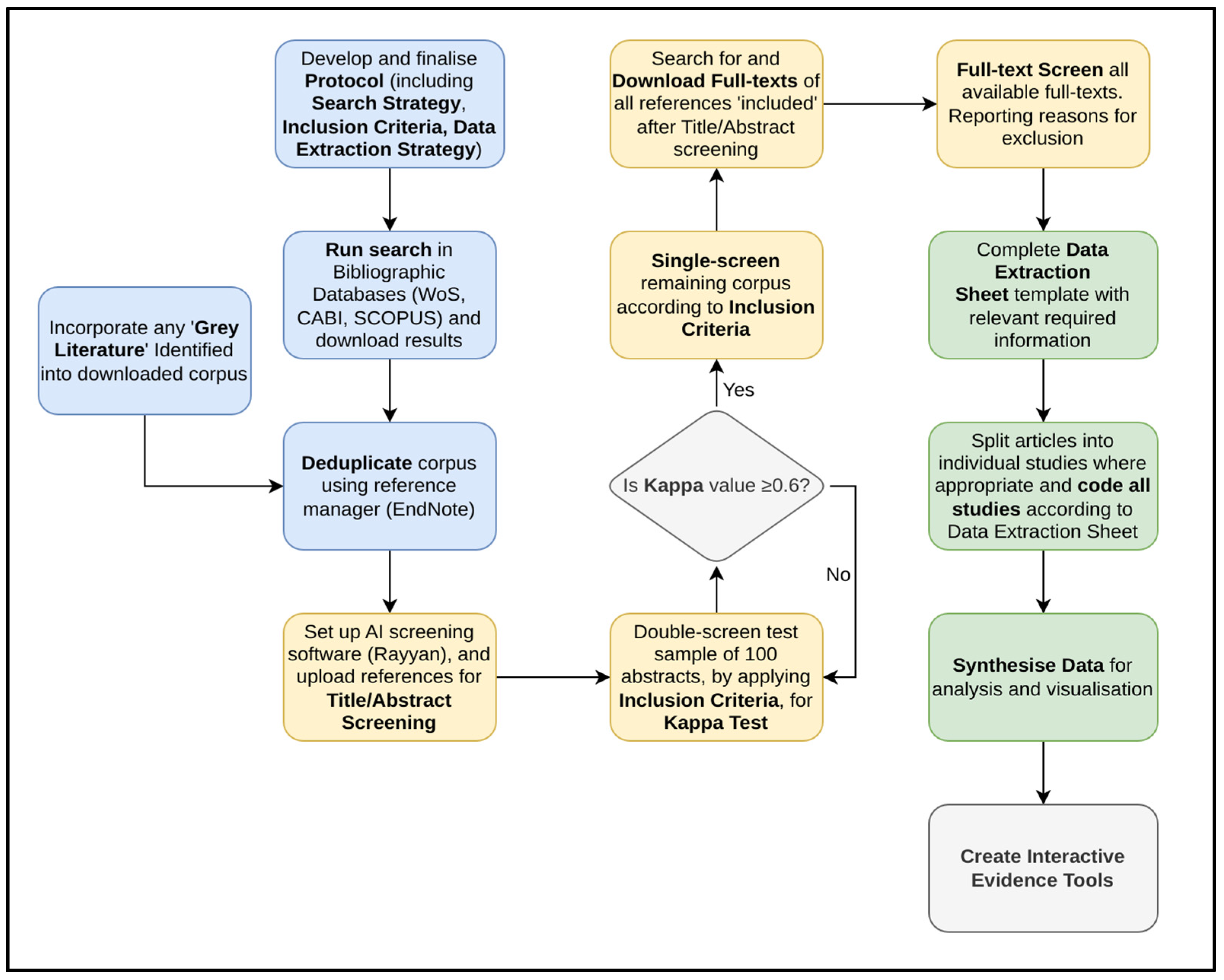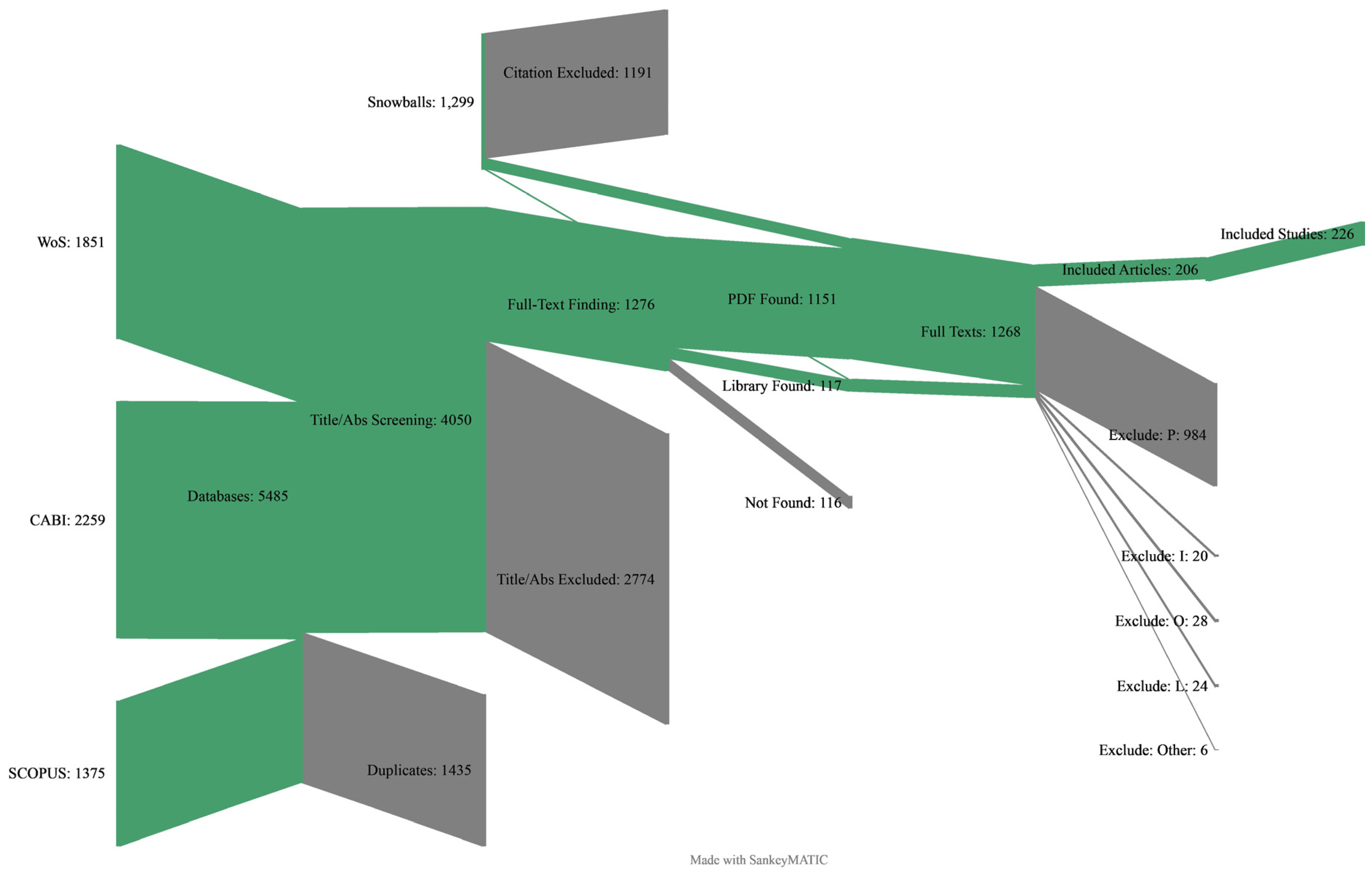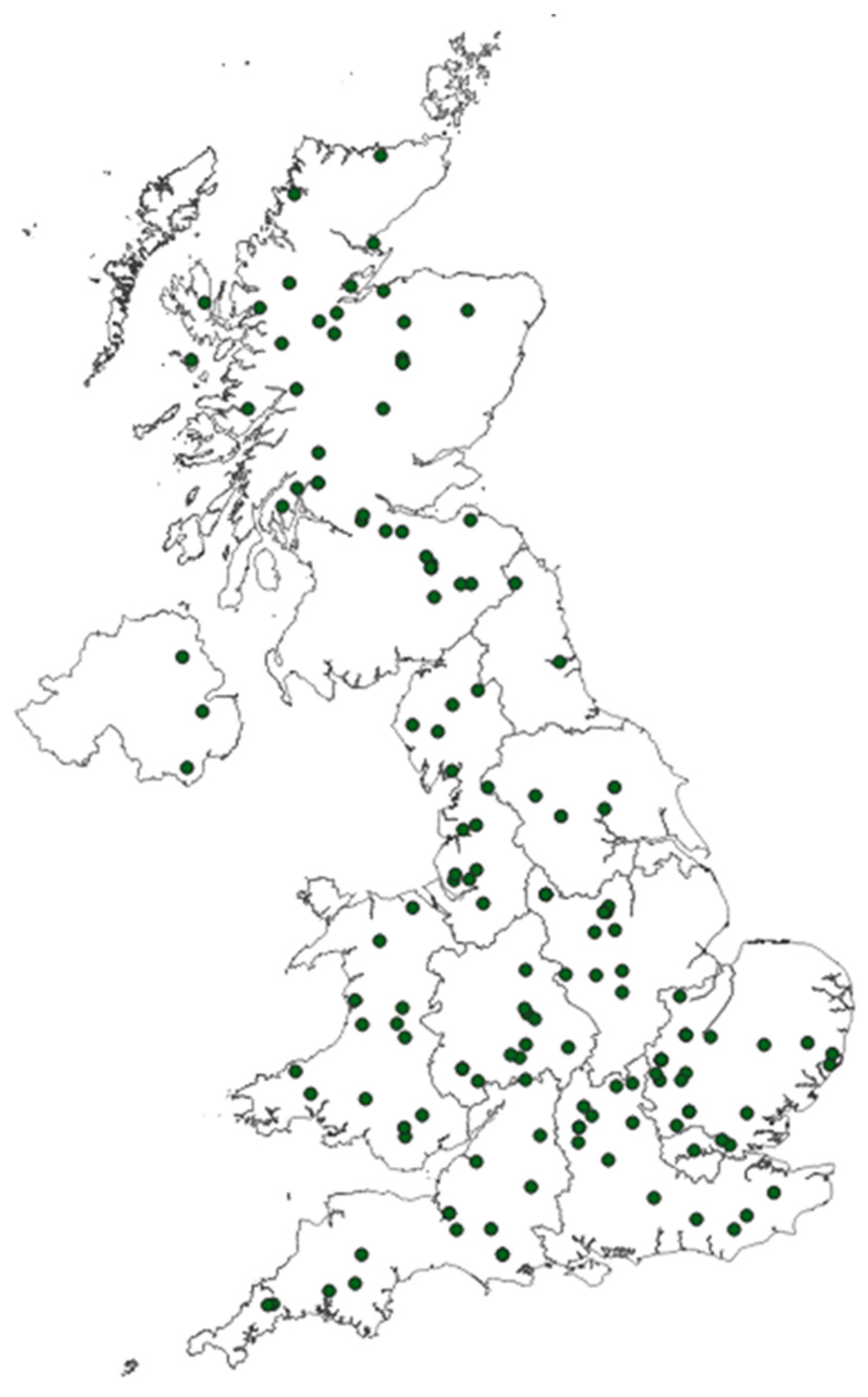Development of a Tool for Navigating the Evidence concerning Land Managers and Woodland Creation in the United Kingdom
Abstract
1. Introduction
- To create a tool that helps researchers and stakeholders navigate the evidence base and access the knowledge they need to address specific queries.
- To gain a comprehensive overview of the evidence of the factors influencing landowners’ and managers’ willingness and ability to create woodland.
- Do influencing factors vary within or between different types of landowners and managers?
- What evidence gaps exist in our understanding of factors that influence willingness or ability among landowners and managers to create woodland?
2. Materials and Methods
2.1. Scope
2.2. Search Strategy
Search Terms
2.3. Selection Strategy
2.4. Synthesis Strategy
2.4.1. Data Coding and Extraction
2.4.2. Data Dashboard
2.4.3. Limitations
3. Results
3.1. Selection of Literature
3.2. Temporal and Spatial Results
3.3. Data Visualisation—Data Dashboard Tool
- Drivers of woodland creation for different types of landowners and managers;
- Drivers of woodland creation in relation to land tenure;
- The types of woodland created by different types of land managers;
- Land management objectives among different types of land managers;
- Land management objectives of different types of farmers.
4. Discussion
5. Conclusions
Supplementary Materials
Author Contributions
Funding
Data Availability Statement
Acknowledgments
Conflicts of Interest
References
- Aronson, J.; Alexander, S. Ecosystem Restoration is Now a Global Priority: Time to Roll up our Sleeves. Restor. Ecol. 2013, 21, 293–296. [Google Scholar] [CrossRef]
- Bastin, J.F.; Finegold, Y.; Garcia, C.; Mollicone, D.; Rezende, M.; Routh, D.; Zohner, C.M.; Crowther, T.W. The global tree restoration potential. Science 2019, 365, 76–79. [Google Scholar] [CrossRef] [PubMed]
- Griscom, B.; Jackson, R.B.; Konijnendijk, C. Trees as Nature-Based Solutions. One Earth 2020, 2, 387–389. [Google Scholar]
- Verdone, M.; Seidl, A. Time, space, place, and the Bonn Challenge global forest restoration target. Restor. Ecol. 2017, 25, 903–911. [Google Scholar] [CrossRef]
- BEIS. The Ten Point Plan for a Green Industrial Revolution: Building back better, supporting green jobs, and accelerating our path to net zero. In Department for Business Energy & Industrial Strategy 2020; HM Government: London, UK, 2020. [Google Scholar]
- Forest Research. Forestry Facts & Figures: A Summary of Statistics about Woodland and Forestry in the UK. 2023. Available online: https://cdn.forestresearch.gov.uk/2023/09/FFF2023.pdf (accessed on 28 November 2023).
- House of Commons, Environment Audit Committee. Seeing the Wood for the Trees: The Contribution of the Forestry and Timber Sectors to Biodiversity and Net Zero Goals. Fifth Report of Session 2022–2023. Report, Together with Formal Minutes Relating to the Report. Ordered by the House of Commons to be Printed 12 July 2023. 2023 HC 637. Available online: https://publications.parliament.uk/pa/cm5803/cmselect/cmenvaud/637/report.html (accessed on 28 November 2023).
- Lawrence, A.; Dandy, N. Private landowners’ approaches to planting and managing forests in the UK: What’s the evidence? Land Use Policy 2014, 36, 351–360. [Google Scholar] [CrossRef]
- Rose, D.C.; Keating, C.; Morris, C. Understand How to Influence Farmers’ Decision-Making Behaviour: A Social Science Literature Review; Report for the Agriculture and Horticulture Development Board (AHDB): Warwickshire, UK, 2018; p. 44. [Google Scholar]
- Staddon, P.; Urquhart, J.; Mills, J.; Goodenough, A.; Powell, J.; Vigani, M.; Simmonds, P.; Rowe, E. Encouraging Woodland Creation, Regeneration and Tree Planting on Agricultural Land: A Literature Review; NEER020; Countryside and Community Research Institute Report to Natural England: Peterborough, UK, 2021. [Google Scholar]
- Wentworth, J.; Jordon, M. Woodland Creation. UK Parliament Research Briefing; UK Parliamentary Office of Science and Technology: London, UK, 2021. [Google Scholar]
- Valatin, G.; Moseley, D.; Dandy, N. Insights from behavioural economics for forest economics and environmental policy: Potential nudges to encourage woodland creation for climate change mitigation and adaptation? For. Policy Econ. 2016, 72, 27–36. [Google Scholar] [CrossRef]
- Lawrence, A.; Dandy, N.; Urquhart, J. Landowner Attitudes to Woodland Creation and Management in the UK. Forest Research, Alice Holt, Farnham. 2010. Available online: https://www.forestry.gov.uk/fr/ownerattitudes (accessed on 28 November 2023).
- Pullin, A.S.; Cheng, S.H.; Cooke, S.J.; Haddaway, N.R.; Macura, B.; Mckinnon, M.C.; Taylor, J.J. Informing conservation decisions through evidence synthesis and communication. In Conservation Research, Policy and Practice; Cambridge University Press: Cambridge, UK, 2020; pp. 114–128. [Google Scholar]
- Purgar, M.; Klanjscek, T.; Culina, A. Quantifying research waste in ecology. Nat. Ecol. Evol. 2022, 6, 1390–1397. [Google Scholar] [CrossRef] [PubMed]
- Glasziou, P.; Chalmers, I. Research waste is still a scandal—An essay by Paul Glasziou and Iain Chalmers. BMJ 2018, 363, k4645. [Google Scholar] [CrossRef]
- Cabinet Office. Modernising Government; White Paper, CM4310; TSO: London, UK, 1999. [Google Scholar]
- Pullin, A.S.; Knight, T.M. Doing more good than harm–Building an evidence-base for conservation and environmental management. Biol. Conserv. 2009, 142, 931–934. [Google Scholar] [CrossRef]
- James, K.L.; Randall, N.P.; Haddaway, N.R. A methodology for systematic mapping in environmental sciences. Environ. Evid. 2016, 5, 7. [Google Scholar] [CrossRef]
- Collaboration for Environmental Evidence. Guidelines and Standards for Evidence synthesis in Environmental Management, Version 5.1.; Pullin, A.S., Frampton, G.K., Livoreil, B., Eds.; Collaboration for Environmental Evidence: Bulgaria, Czech Republic, 2022. Available online: https://www.environmentalevidence.org/information-for-authors (accessed on 28 November 2023).
- Snilstveit, B.; Bhatia, R.; Rankin, K.; Leach, B. 3ie Evidence Gap Maps: A Starting Point for Strategic Evidence Production and Use; 3ie Working Paper 28; International Initiative for Impact Evaluation: New Delhi, India, 2017. [Google Scholar]
- Littell, J.H.; White, H. The Campbell Collaboration: Providing Better Evidence for a Better World. Res. Soc. Work. Pract. 2018, 28, 6–12. [Google Scholar] [CrossRef]
- Ouzzani, M.; Hammady, H.; Fedorowicz, Z.; Elmagarmid, A. Rayyan—A web and mobile app for systematic reviews. Syst. Rev. 2016, 5, 210. [Google Scholar] [CrossRef] [PubMed]
- Lombard, M.; Snyder-Duch, J.; Bracken, C.C. Content Analysis in Mass Communication: Assessment and Reporting of Intercoder Reliability. Hum. Commun. Res. 2002, 28, 587–604. [Google Scholar] [CrossRef]
- Church, S.; Dunn, M.; Prokopy, L. Benefits to Qualitative Data Quality with Multiple Coders: Two Case Studies in Multi-coder Data Analysis. J. Rural. Soc. Sci. 2019, 34, 2. [Google Scholar]
- Frampton, G.K.; Livoreil, B.; Petrokofsky, G. Eligibility screening in evidence synthesis of environmental management topics. Environ. Evid. 2017, 6, 27. [Google Scholar] [CrossRef]
- Sievert, C.; Interactive Web-Based Data Visualization with R, Plotly, and Shiny. 19 December 2019. Available online: https://plotly-r.com/ (accessed on 23 January 2024).





| Coded Element | Individual Data Fields |
|---|---|
| Article Metadata | Reference Type, Year, Author, Author Institution, Title, Journal Title, ISBN/ISSN, DOI, URL, Abstract, Volume, Issue, Pages |
| Study Location | Scale of Study, Number of Study Sites, UK Nation, Lat/Lon (DD) |
| Land Management and Setting/Contextual Information | Study Question/Objective(s), Study Type, Sample Size, Altitude, Rural/Urban Setting, Land Manager Type, Ownership, Area of Land Owned/Managed, Units of Land |
| Drivers and Barriers to Woodland Creation | Economic Conditions, Economic Incentives (Public), Economic Incentives (Private), Regulation, Personal/Company Circumstances, Land or Resource Suitability, Operational, Knowledge/Skills/Experience/Awareness, Networks and Partnerships, Access to Advice and Research, Cultural factors, Attitudes and Values, Land Manager Objectives |
| Outcomes | Woodland Creation Status, Woodland Type, Establishment, Provenance and/or Genetics |
Disclaimer/Publisher’s Note: The statements, opinions and data contained in all publications are solely those of the individual author(s) and contributor(s) and not of MDPI and/or the editor(s). MDPI and/or the editor(s) disclaim responsibility for any injury to people or property resulting from any ideas, methods, instructions or products referred to in the content. |
© 2024 by the authors. Licensee MDPI, Basel, Switzerland. This article is an open access article distributed under the terms and conditions of the Creative Commons Attribution (CC BY) license (https://creativecommons.org/licenses/by/4.0/).
Share and Cite
Petrokofsky, G.; Dunn, M.; Edwards, D.; Harvey, W.J.; Hemery, G.E.; Marshall, H.; McConnachie, S.; Petrokofsky, L.; Watts, K.; Ambrose-Oji, B. Development of a Tool for Navigating the Evidence concerning Land Managers and Woodland Creation in the United Kingdom. Forests 2024, 15, 299. https://doi.org/10.3390/f15020299
Petrokofsky G, Dunn M, Edwards D, Harvey WJ, Hemery GE, Marshall H, McConnachie S, Petrokofsky L, Watts K, Ambrose-Oji B. Development of a Tool for Navigating the Evidence concerning Land Managers and Woodland Creation in the United Kingdom. Forests. 2024; 15(2):299. https://doi.org/10.3390/f15020299
Chicago/Turabian StylePetrokofsky, Gillian, Michael Dunn, David Edwards, William J. Harvey, Gabriel E. Hemery, Harry Marshall, Stephen McConnachie, Leo Petrokofsky, Kevin Watts, and Bianca Ambrose-Oji. 2024. "Development of a Tool for Navigating the Evidence concerning Land Managers and Woodland Creation in the United Kingdom" Forests 15, no. 2: 299. https://doi.org/10.3390/f15020299
APA StylePetrokofsky, G., Dunn, M., Edwards, D., Harvey, W. J., Hemery, G. E., Marshall, H., McConnachie, S., Petrokofsky, L., Watts, K., & Ambrose-Oji, B. (2024). Development of a Tool for Navigating the Evidence concerning Land Managers and Woodland Creation in the United Kingdom. Forests, 15(2), 299. https://doi.org/10.3390/f15020299






